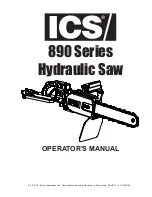
11
English
the latest regulations for packaging, labeling/marking and
documentation requirements.
The information provided in this section of the manual is
provided in good faith and believed to be accurate at the time
the document was created. However, no warranty, expressed or
implied, is given. It is the buyer’s responsibility to ensure that its
activities comply with the applicable regulations.
Transporting the FlEXVOlT
TM
Battery
The
D
e
WALT
FLEXVOLT
TM
battery has two modes:
Use
and
Transport
.
Use Mode:
When the FLEXVOLT
TM
battery stands alone or is in
a
D
e
WALT
18V product, it will operate as an 18V battery. When
the FLEXVOLT
TM
battery is in a 54V or a 108V (two 54V batteries)
product, it will operate as a 54V battery.
Transport Mode:
When the cap is attached to the FLEXVOLT
TM
battery, the battery is in Transport mode. Keep the cap
for shipping.
When in Transport mode, strings
of cells are electrically
disconnected within the pack
resulting in 3 batteries with a
lower Watt hour (Wh) rating as compared to 1 battery with a
higher Watt hour rating. This increased quantity of 3 batteries
with the lower Watt hour rating can exempt the pack from
certain shipping regulations that are imposed upon the higher
Watt hour batteries.
For example, the Transport
Wh rating might indicate
3 x 36 Wh, meaning
3 batteries of 36 Wh each.
The Use Wh rating might
indicate 108 Wh (1 battery implied).
Storage Recommendations
1. The best storage place is one that is cool and dry away
from direct sunlight and excess heat or cold. For optimum
battery performance and life, store battery packs at room
temperature when not in use.
2. For long storage, it is recommended to store a fully charged
battery pack in a cool, dry place out of the charger for
optimal results.
nOTE:
Battery packs should not be stored completely depleted
of charge. The battery pack will need to be recharged before use.
Labels on Charger and Battery Pack
In addition to the pictographs used in this manual, the
labels on the charger and the battery pack may show the
following pictographs:
L
Read instruction manual before use.
p
See
Technical Data
for charging time.
q
Do not probe with conductive objects.
Example of Use and Transport Label Marking
•
Contents of opened battery cells may cause respiratory
irritation.
Provide fresh air. If symptoms persists, seek
medical attention.
WARNING:
Burn hazard. Battery liquid may be flammable
if exposed to spark or flame.
WARNING:
Never attempt to open the battery pack for
any reason. If battery pack case is cracked or damaged,
do not insert into charger. Do not crush, drop or damage
battery pack. Do not use a battery pack or charger that
has received a sharp blow, been dropped, run over or
damaged in any way (i.e., pierced with a nail, hit with
a hammer, stepped on). Electric shock or electrocution
may result. Damaged battery packs should be returned to
service centre for recycling.
WARNING: Fire hazard. Do not store or carry the
battery pack so that metal objects can contact
exposed battery terminals.
For example, do not place
the battery pack in aprons, pockets, tool boxes, product kit
boxes, drawers, etc., with loose nails, screws, keys, etc.
CAUTION:
When not in use, place tool on its side on
a stable surface where it will not cause a tripping
or falling hazard.
Some tools with large battery packs
will stand upright on the battery pack but may be easily
knocked over.
Transportation
WARNING: Fire hazard.
Transporting batteries can
possibly cause fire if the battery terminals inadvertently
come in contact with conductive materials. When
transporting batteries, make sure that the battery
terminals are protected and well insulated from
materials that could contact them and cause a short
circuit.
NOTE:
Lithium‑ion batteries should not be put in
checked baggage.
D
e
WALT
batteries comply with all applicable shipping
regulations as prescribed by industry and legal standards which
include UN Recommendations on the Transport of Dangerous
Goods; International Air Transport Association (IATA) Dangerous
Goods Regulations, International Maritime Dangerous Goods
(IMDG) Regulations, and the European Agreement Concerning
The International Carriage of Dangerous Goods by Road
(ADR). Lithium‑ion cells and batteries have been tested to
section 38.3 of the UN Recommendations on the Transport of
Dangerous Goods Manual of Tests and Criteria.
In most instances, shipping a
D
e
WALT
battery pack will be
excepted from being classified as a fully regulated Class
9 Hazardous Material. In general, only shipments containing a
lithium‑ion battery with an energy rating greater than 100 Watt
Hours (Wh) will require being shipped as fully regulated Class 9.
All lithium‑ion batteries have the Watt Hour rating marked on
the pack. Furthermore, due to regulation complexities,
D
e
WALT
does not recommend air shipping lithium‑ion battery packs
alone regardless of Watt Hour rating. Shipments of tools with
batteries (combo kits) can be air shipped as excepted if the Watt
Hour rating of the battery pack is no greater than 100 Wh.
Regardless of whether a shipment is considered excepted
or fully regulated, it is the shipper's responsibility to consult
Summary of Contents for DCS573 GB
Page 1: ...DCS573 ...
Page 2: ...B Copyright DeWALT English original instructions 5 ...
Page 3: ...1 Fig A Fig B 1 2 12 11 15 9 5 7 8 6 13 10 3 14 13 3 13 3 20 ...
Page 5: ...3 9 25 12 Fig J Fig I Fig K Fig M Fig L Fig N 23 22 ...
Page 6: ...4 12 24 37 4 36 37 24 26 27 28 Fig P Fig O Fig R Fig Q Fig S ...
Page 21: ......
Page 22: ......
Page 23: ......










































